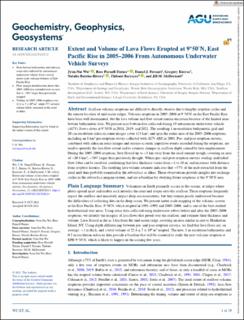Extent and Volume of Lava Flows Erupted at 9°50′N, East Pacific Rise in 2005–2006 From Autonomous Underwater Vehicle Surveys
Wu, Jyun-Nai; Parnell-Turner, Ross; Fornari, Daniel J.; Kurras, Gregory; Berrios-Rivera, Natalia; Barreyre, Thibaut; McDermott, Jill M.
Journal article, Peer reviewed
Published version

Åpne
Permanent lenke
https://hdl.handle.net/11250/3055041Utgivelsesdato
2022Metadata
Vis full innførselSamlinger
- Department of Earth Science [1050]
- Registrations from Cristin [9791]
Originalversjon
Geochemistry Geophysics Geosystems. 2022, 23 (3), e2021GC010213. 10.1029/2021GC010213Sammendrag
Seafloor volcanic eruptions are difficult to directly observe due to lengthy eruption cycles and the remote location of mid-ocean ridges. Volcanic eruptions in 2005–2006 at 9°50′N on the East Pacific Rise have been well documented, but the lava volume and flow extent remain uncertain because of the limited near-bottom bathymetric data. We present near-bottom data collected during 19 autonomous underwater vehicle (AUV) Sentry dives at 9°50′N in 2018, 2019, and 2021. The resulting 1 m-resolution bathymetric grid and 20 cm-resolution sidescan sonar images cover 115 km2, and span the entire area of the 2005–2006 eruptions, including an 8 km2 pre-eruption survey collected with AUV ABE in 2001. Pre- and post-eruption surveys, combined with sidescan sonar images and seismo-acoustic impulsive events recorded during the eruptions, are used to quantify the lava flow extent and to estimate changes in seafloor depth caused by lava emplacement. During the 2005–2006 eruptions, lava flowed up to ∼3 km away from the axial summit trough, covering an area of ∼20.8 km2; ∼50% larger than previously thought. Where pre- and post-eruption surveys overlap, individual flow lobes can be resolved, confirming that lava thickness varies from ∼1 to 10 m, and increases with distance from eruptive fissures. The resulting lava volume estimate indicates that ∼57% of the melt extracted from the axial melt lens probably remained in the subsurface as dikes. These observations provide insights into recharge cycles in the subsurface magma system, and are a baseline for studying future eruptions at the 9°50′N area.
